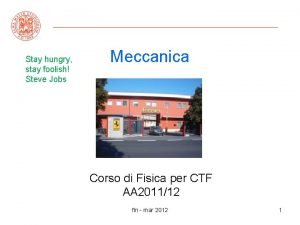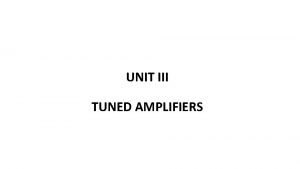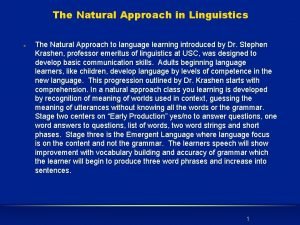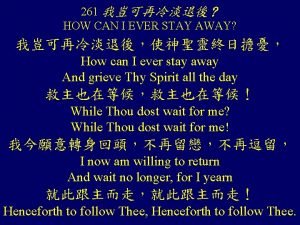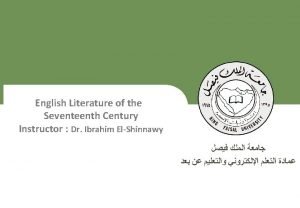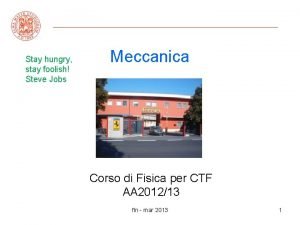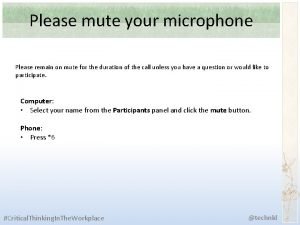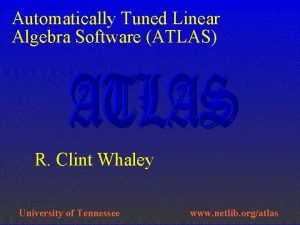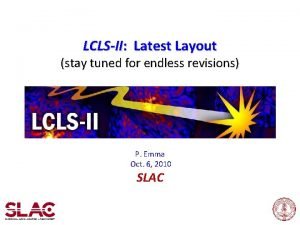v PLEASE STAY TUNED TO THE SPEAKER Acknowledgements

















- Slides: 17

v. PLEASE STAY TUNED TO THE SPEAKER Acknowledgements 06 -Mar-21 1

ELECTRODYNAMIC (ELECTRODYNAMOMETER OR DYNAMOMETER) MOVING COIL TYPE INSTRUMENT A Presentation / Talk By Dr. J. S. Saini Prof. , EED; Dean, Faculty of Engg. & Tech. , D. C. R. Univ. of Sci. & Tech. , Murthal, Sonipat Ph. : 9416351300, 9416354914, Email: jssain@rediffmail. com Reference: J. S. Saini, “Textbook of Measurements and Instrumentation (With Laboratory Experiments)” As per AICTE Model Curriculum 3/6/2021 Pub. : New Age Publishers, New Delhi.

CONTENTS ELECTRODYNAMIC (ELECTRODYNAMOMETER OR DYNAMOMETER) MOVING COIL TYPE INSTRUMENT 1. MOTIVATION 2. MOVING COIL INSTRUMENT 2. 1 PERMANENT MAGNET MOVING COIL (PMMC) TYPE …. . . 2. 2 ELECTRODYNAMIC (ELCTRODYNAMOMETER / DYNAMOMETER) TYPE 2. 2. 1 2. 2. 2. 3 2. 2. 4 2. 2. 5 Construction Operating Principle & Torque Equation Electrodynamic Voltmeters Electrodynamic Ammeters Use as a Transfer Instrument 3. MOVING IRON INSTRUMENT (IRON-VANE INSTRUMENT) …. . . 06 -Mar-21 Dr. J. S. Saini, Prof. , EED; Dean, Faculty of Engg. & Tech. , Ph. : 9416351300, Email: jssain@rediffmail. com 3

2. 2 ELECTRODYNAMOMETER (OR DYNAMOMETER OR ELECTRODYNAMIC) MOVING COIL TYPE: • Motivation for studying this instrument comes from following 4 facts: • It has two independent ckts. (thus 2 independent i/ps to movement) that permit its use in diff. applications such as I-, V-, W-, VAR-meters, p. f. meters and freq. meters. • To calibrate all indicating type instruments, standards of V and R reqd. As available standard of voltage, i. e. , Weston Standard Cell, is a D. C. cell, so, impossible to calibrate an A. C. instrument directly against fundamental standards. • Need of an instrument (called ‘transfer instrument’) equally accurate on both A. C. & D. C. The Electrodynamic instrument, is an ideal ‘transfer instrument (separate sec. ) • PMMC can’t measure A. C. , but electrodynamic instrument can measure both A. C. (since product of two –ve currents also yields +ve qty. ) & D. C. 06 -Mar-21 Dr. J. S. Saini, Prof. , EED; Dean, Faculty of Engg. & Tech. , Ph. : 9416351300, Email: jssain@rediffmail. com 4

2. 2. 1 Construction: • Construction similar to that of PMMC instrument, except: in PMMC, air gap flux produced by permanent magnet, in the electrodynamic instrument, it is produced by an air-cored electromagnet. • Electromagnet is made of an air-cored fixed coil (called field coil) which carries current from (or a current proportional to) the qty. being measured. • Fixed coil in 2 sections (2 coils) to give uniform field near centre of these 2 coils & to allow a moving coil (again air-cored) to be housed at centre; fixed coils spaced far apart to allow passage of shaft of movable coil as in Fig. 7. Schematic: Fig. 8. Fig. 7 Electrodynamic Instrument 06 -Mar-21 Fig. 8 Schematic diagram of electrodynamic movement. 5 Dr. J. S. Saini, Prof. , EED; Dean, Faculty of Engg. & Tech. , Ph. : 9416351300, Email: jssain@rediffmail. com

• Symbols C, for fixed coil, & P, for movable coil, are used as in wattmeter applications, fixed coil is called current coil, & movable coil is called potential coil. • Air-cored moving coil: wound as self-sustaining coil or on non-metallic former. Avoid any metal (in cores, formers or supports, etc. ) in such instruments to avoid errors due to hysteresis, eddy currents & other errors if instrument used on A. C. • Controlling torque (τC) provided by 2 control springs if pivot-&-bearings support moving system. Pivot-less supports: τC provided by suspension (simple or taut-band, as case may be). Control springs suspensions also serve as leads for current to moving coil. • As neither permanent magnet (P. M. ) nor moving non-magnetic metallic disc form a part of operating system, so in such instruments, the damping usually: air friction damping: by a piston or a vane moving in enclosed air. • Eddy current damping can be provided by specifically an aluminium disc rotating in field of a specially provided P. M. As magnetic / metallic parts are involved in both above cases of damping, such damping mechanism 06 -Mar-21 6 be isolated (though on same shaft) from main operating system. Dr. J. S. Saini, Prof. , EED; Dean, Faculty of Engg. & Tech. , Ph. : 9416351300, Email: jssain@rediffmail. com

2. 2. 2 Operating Principle & Torque Equation: • Operation of Electrodynamic instrument well understood by looking at limitation of PMMC for its use on A. C. (see 2. 1. 5). • Now, if we reverse direction of field flux (not possible in PMMC instrument, as permanent magnets provide unidirectional field flux) each time current through movable coil reverses, the torque produced would be in same direction for both halves of A. C. cycle. • How can we reverse field flux simultaneously with reversal of current in movable coil? Clearly, this is done by connecting field coil in series with movable coil. Can the same objective be achieved by connecting fixed & moving coils in parallel? Answer is ‘yes’ (**) • To derive torque expression, first consider a general case in which currents in fixed & moving coils are different; later consider particular cases depending upon whether moving coils are in series (as in voltmeters) or in parallel. (** provided, of course, if division of current in the two parallel branches is made independent of freq. This is possible if L/R ratios (time constants) of the two parallel branches are made the same, which also means: currents in the two parallel branches are in phase, or p. f. ’s of two branches are same. 06 -Mar-21 7 Dr. J. S. Saini, Prof. , EED; Dean, Faculty of Engg. & Tech. , Ph. : 9416351300, Email: jssain@rediffmail. com

• Let ic = instantaneous value of current in the fixed coils, in A. ip = instantaneous value of current in the moving coils, in A. Lc = self-inductance of fixed coils, in H. Lp = self-inductance of moving coils, in H. M = mutual-inductance between the fixed and the moving coils, in H. So, total instantaneous energy stored in magnetic field is: W =(ic)2 Lc /2 + (ip)2 Lp /2 + icip M (5) • Now let moving system rotate thro’ a small angle dθ & corres. . change in energy is d. W, then work done in moving the system = change in energy d. W, i. e. , d. W = τdi x dθ (6) where τdi = instantaneous deflecting torque. So, τdi = d. W/dθ Differentiating Eqn. 5, we get: τdi = (1/2) (ic)2(d. Lc /dθ) +(1/2) (ip)2(d. Lp /dθ) + icip (d. M/dθ) (7) • As Lc & Lp: const. w. r. t. angle of deflection of moving coil, so, Eqn. 7 reduces to: 06 -Mar-21 8 Dr. J. S. Saini, Prof. , EED; Dean, Faculty of Engg. & Tech. , Ph. : 9416351300, Email: jssain@rediffmail. com

τdi = icip (d. M/dθ) (8) • Clearly, instantaneous deflecting torque not only depends on instantaneous currents in fixed & moving coils but also on rate of change of mutual inductance with deflection. • CASE-1 Operation with D. C. : Let D. C. currents in fixed & moving coils be Ic & Ip resp. , in A. So, replacing the instantaneous currents in Eqn. (8) with D. C. currents, we get: Unidirectional Torque, τ = Ic Ip (d. M/dθ) (9) Now let this steady torque deflect the moving mechanism to a final steady deflection position, θ. So, Controlling torque τc = Kθ (as only spring control is used in electrodynamic instruments) where K = Spring constant. At final steady position, τc = τd. So, Kθ = Ic Ip (d. M/dθ) Or, deflection, θ =(Ic Ip/K )(d. M/dθ) 06 -Mar-21 (10) 9 Dr. J. S. Saini, Prof. , EED; Dean, Faculty of Engg. & Tech. , Ph. : 9416351300, Email: jssain@rediffmail. com

• CASE-2: Operation with Sinusoidal A. C. : Various possibilities of connecting C & P coils (e. g. , in series, in parallel, in series with a resistance, etc. ) are particular cases, but let us consider a general case in which currents ic and ip are sinusoidal & have a phase difference of angle , i. e. , ic = Imc Sin t ip = Imp Sin( t – ) So, Average deflecting torque over a complete cycle is: 06 -Mar-21 10 Dr. J. S. Saini, Prof. , EED; Dean, Faculty of Engg. & Tech. , Ph. : 9416351300, Email: jssain@rediffmail. com

Where Ic & Ip are the r. m. s. values of currents in C and P coils respectively. • So, conclusion: for sinusoidal A. C. , deflection is proportional to product of R. M. S. values of coil currents, cosine of phase angle between them & rate of change of mutual inductance with deflection. • But, with a careful design of coil sections & radii, possible to obtain constancy of (d. M/dθ) over usual working range. In such a case, Eqn. 12 reduces to: 06 -Mar-21 11 Dr. J. S. Saini, Prof. , EED; Dean, Faculty of Engg. & Tech. , Ph. : 9416351300, Email: jssain@rediffmail. com

2. 2. 3 Electrodynamic Voltmeters: Basic electrodynamic movement converted to a voltmeter by connecting C & P coils in series along with a high non-inductive series resistance as in Fig. 9. Since the two coils are in series, Ic = Ip = V/Z and also = 0 where V = RMS voltage across the instrument circuit, and Z = total impedance of the instrument circuit. Rs = extra series resistance & rs = total series resistance of two coils (C and P) Leq = Equivalent inductance of the total circuit. 06 -Mar-21 12 Dr. J. S. Saini, Prof. , EED; Dean, Faculty of Engg. & Tech. , Ph. : 9416351300, Email: jssain@rediffmail. com

Fig. 9 Electrodynamic Voltmeter. So, From Eqn. 12, Or, if (d. M / dθ) = constant by suitable design of coils, then θ = V 2/ (KZ 2) (15) Following conclusions can be made, with benefit, from above two Eqns. : a) Deflection of electrodynamic voltmeter sq. of RMS value of voltage measured. In other words, V ( θ), voltage is proportional to sq. root of angle of deflection. So, scale of such instruments: cramped at lower end & spread out at high end, i. e. , ‘square law’ response. b) Since deflection is also dependent upon impedance, Z, so, series resistor 06 -Mar-21 13 must be large compared to reactance of coils so that ‘Z’ may be made more Dr. J. S. Saini, Prof. , EED; Dean, Faculty of Engg. & Tech. , Ph. : 9416351300, Email: jssain@rediffmail. com or less frequency independent; otherwise frequency will affect calibration of

2. 2. 4 Electrodynamic Ammeters: • A simple series connection of C & P coils (without any external series or shunt resistances) can be regarded as an ammeter. • But this arrangement impractical above 200 m. A, as current carrying capacity of control springs is limited. To carry large currents to moving coil, the control springs or other lead-in wires need to be thick which ⟹ sacrificing (loosing) their flexibility. • Also, for large currents, a heavy moving coil reqd. So, to measure large currents, arrangement of Fig. 10 is apt, in which a shunt placed across movable coil alone to limit current through it. • Fixed coils in Fig. 10 can be made of heavy wire which can carry large total current. • But, arrangement (Fig. 10) will not read correctly at all frequencies as division of I into Ip & Ish is dependent upon frequency. Fig. 10 Arrangement to measure large currents (but with frequencydependence). 06 -Mar-21 14 Dr. J. S. Saini, Prof. , EED; Dean, Faculty of Engg. & Tech. , Ph. : 9416351300, Email: jssain@rediffmail. com

• To overcome above difficulty, arrangement of Fig. 11 is used: Fig. 11 Arrangement to measure large currents (& with frequencyindependence). • By this arrangement, time constants (L/R ratios) of two parallel branches are easily made equal (it also ⟹ p. f. angles of two branches are same), & thereby making division of current in two paths independent of frequency. • Using such arrangements, possible to measure currents upto 20 A. For still larger A. C. currents, a current transformer (C. T. ) & a standard 5 A A. C. ammeter used. • Since deflection is proportional to square of the RMS value of current being measured, the electrodynamic ammeters also follow ‘square law’ response. • Connection (Fig. 11) gives frequency independence only if L/R ratios of two parallel branches is made the same (achieveable through use of a swamping resistance). 06 -Mar-21 15 Dr. J. S. Saini, Prof. , EED; Dean, Faculty of Engg. & Tech. , Ph. : 9416351300, Email: jssain@rediffmail. com

2. 2. 5 Use as a Transfer Instrument: • Observe Eqns. for deflection for D. C. (Eqn. 10) & for sinusoidal A. C. (Eqn. 12), ⟹ essentially no difference between the two if Cos = 1, i. e. , = 0 and that (d. M / dθ) is same for D. C. & A. C. • Above section ⟹ possible to achieve = 0 by making L/R ratios same for two parallel circuits. • As regards (d. M / dθ) being same for D. C. & A. C. , appreciate: in a well-designed instrument, operation with A. C. at power frequencies is disturbed very little by stray capacitance & eddy current effects. • So, if electrodynamic ammeter is calibrated with 1 A D. C. , then an A. C. of 1 A (r. m. s) would also give same deflection. Electrodynamic ammeter can, thus, be used as a ‘transfer’ instrument to calibrate A. C. meters in terms of D. C. standards. • Caution: This calibration holds with good accuracy at power frequencies only (as at higher frequencies, stray capacitance & eddy current effects affect (d. M / dθ). • This is one of the most important applications of electrodynamic instruments. Another important application is electrodynamic wattmeters. 3/6/2021

THANKS. ANY QUESTIONS PLEASE? Reference: J. S. Saini, “Textbook of Measurements and Instrumentation (With Laboratory Experiments)” As per AICTE Model Curriculum Pub. : New Age Publishers, New Delhi. 06 -Mar-21 Dr. J. S. Saini, Prof. , EED; Dean, Faculty of Engg. & Tech. , Ph. : 9416351300, Email: jssain@rediffmail. com 17
 Stay hungry stay foolish significato
Stay hungry stay foolish significato Stay hungry stay foolish examples
Stay hungry stay foolish examples Classification of tuned amplifier
Classification of tuned amplifier Roughly-tuned input definition
Roughly-tuned input definition Stay tuned online
Stay tuned online So stay so stay 再知己
So stay so stay 再知己 Where you go i'll go where you stay i'll stay
Where you go i'll go where you stay i'll stay Fair daffodils we weep to see theme
Fair daffodils we weep to see theme I hope the days come easy
I hope the days come easy Good morning tuesday stay safe images
Good morning tuesday stay safe images In the afternoon i stay home
In the afternoon i stay home Stay hungry stay foolish significato
Stay hungry stay foolish significato Please mute your microphone when not speaking
Please mute your microphone when not speaking Will you please be quiet please summary
Will you please be quiet please summary Clint whaley
Clint whaley The miracle of language
The miracle of language Roughly tuned input
Roughly tuned input Tesol methodology
Tesol methodology
